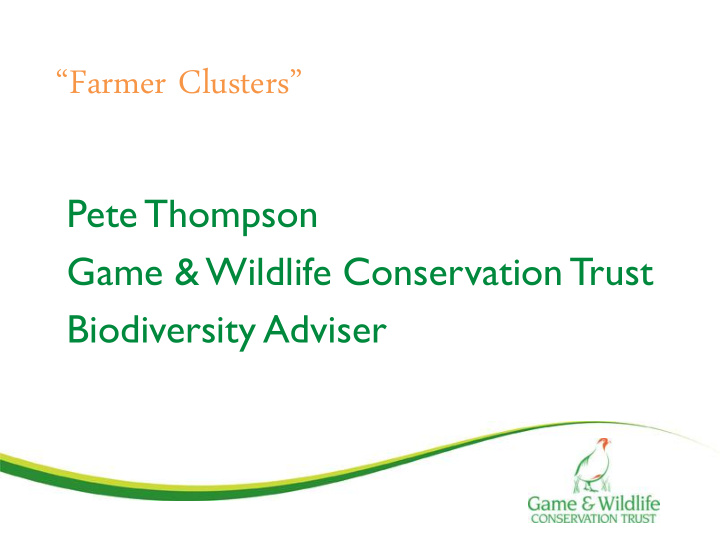



“Farmer Clusters” Pete Thompson Game & Wildlife Conservation Trust Biodiversity Adviser
Landscape scale - the best way to manage soil, water & wildlife?
So, what are “Farmer Clusters”? • Farmer clusters set out to improve soil, water and wildlife, by a number of farmers joining forces to work closely together on a landscape scale, rather than as individuals on their own farms.
But, will farmers work together and do they understand the potential benefits? • Absolutely, but a good “leader” is crucial. • They find this new approach - listening to them and helping them to address issues – more bottom-up & less top down – very refreshing. • They enjoy the social aspect. • They feel empowered by having ownership of their own group. •
It is ALL about “bottom - up” and NOT “top - down” - plus working together
Farming – the good life! – CAP Greening measures. Water framework directive. SSAFO. – Pesticide regulation. Neonicotinoids. Pollinators. Farmland birds. – Biodiversity. Bees. Controlled traffic farming. Precision farming. – Minimum tillage. Rotations. Resistance. Disease. LERAPS. CRD. – X compliance. Welfare regulations. Access. GAEC. Poaching. – RPA inspections. Fly tipping. Flooding. Drought. Climate change. – Badgers & TB. NVZs. Sewage sludge. Farm animal ID. GHGAP. – Sustainable Use Directive .Environmental impact assessments. – SSSI’s. Scheduled monuments. CPD. Hedgerow regulations. – Soil protection review. Control of noxious weeds. Diffuse pollution. – Tree preservation orders. Catchment sensitive farming. HSE. – Soil erosion. Off road vehicles. NRoSO. Food Hygiene Regulations. – CPD. Water abstraction. Disposal of hazardous waste. Crow act. Point source pollution. Safe disposal of enzyme treated sheep dip. – Voluntary initiative. Tried & T ested. Wildlife & countryside act. – Nitrates Action Programme (NAP) & Phosphorus Regulations ............ –
Training: • Bring training events to the farmers – relevant to the area • The farmers choose what they want or need up-dating on • They choose when, where, how, and by whom
Engaging with the public
Monitoring: Harvest mouse survey – Selborne Farmer’s cluster
An quick lesson on how to find a harvest mouse nest!
Harvest mouse nest
Ready for the off!
Harvest mice around Selborne • One record for the species in a 5km radius of the village – way back in 1999 on a nature reserve! • Assorted volunteers, including many farmers turned up to survey • Nobody had ever found a nest before. • At the end of the day we had found 159 nests! • The survey continued and has now found and recorded 481 nests in the area
DEFRA minister Liz Truss visiting the Selborne Landscape partnership
The facilitation fund
Facilitated groups: • Worth 7.2 million over 3 years • 49 farmer clusters • 981 farmers involved • Covering 210,404 hectares (519,697 acres) • 12 more farmer clusters targeting flood prone areas
Martin Down “super cluster” – around 33 farmers covering 12,000+ hectares
Farmer clusters – the future?
Recommend
More recommend